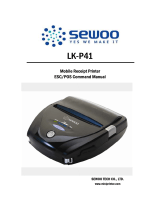2-2. The printer stops printing.
If the Error light is on (but not blinking), the printer is off line.
Check to see that the covers are closed and check the paper state.
See Chapter 1 for instructions on installing or replacing the paper roll.
If the Error light is blinking, there is an error. In this case, turn off the
printer for a few seconds and then turn it back on.
If the light is still blinking, call your supervisor or a service person.
Turn off the printer and check for a paper jam.
To clear paper jam, follow th steps below:
1) Turn the printer off and open the rear cover of the printer.
2) Remove the jammed paper and reload the paper roll as described in Chapter1.
3) Check the position of circular cutter in Auto Cutter Assembly.
If it is not located in Home Position(Right-Hand Side End),
Turn the printer on to locate it on Home position.
4) Close the rear cover.
Troubleshooting
Chapter 2
1615
2-4. Printing is poor
Obstructed ink nozzles in the print head and lower the print quality.
Try cleaning the print head as described below:
1) Make sure that the printer is turned on.
2) Press the Clean button.
The printer begins its self cleaning process, which takes less than 5 seconds.
The power light blinks during the cleaning process.
3) When the cleaning action is finished (Power light is ON), resume printing
or run a self test (as described in Chapter 1).
4) If the printing quality has not improved, repeat this process 2-3 more times.
If the printing quality has not still improved, replace the ink cartridge.
If, after the new ink cartridge has been installed, the printing quality has not still
improved, call your supervisor or a service person.
2-3. You want to check the operation of the printer by itself.
Self test
Try to run the self test to check that the printer works properly.
See the self test instructions in Chapter 1 to run the self test.
If the self test does not work, contact your supervisor or a service person.
If the self test works properly, check the following:
If the printer still does not print, contact your dealer or a qualified service person.
1) Check the connection at both ends of the interface cable between the printer
and the computer. Also make sure that this cable meets the specifications for
both the printer and the computer.
2) The data transmission settings may be different between the printer and
computer. Make sure that the printer’s DIP switch settings for data transmission
are the same as the computer’s. You can see the printer’s interface settings
on your self test printout.
Cleaning the print head




















